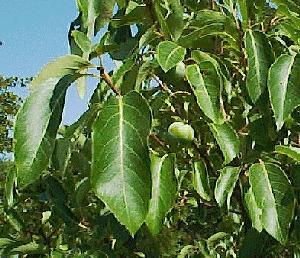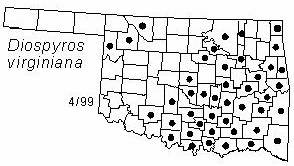
Small or medium sized tree to 18 m (60 ft) tall and 50 cm (20 in) diameter. Bark dark brown to black, thick, fissured into small squarish blocks. Twigs thin, slightly zigzag, brownish or gray. Buds small, pointed, with two brown shiny scales, no terminal bud. Leaves alternate, ovate to elliptic, 6-15 cm (2.4-6 in) long and 4-7.5 cm (1.6-3 in) wide, entire, usually somewhat acuminate, rounded at base, shiny glabrous dark green above, whitish and glabrous to densely hairy below. Flowers scattered, short-stalked or sessile at leaf bases, with a bell-shaped 4-lobed white corolla 10-15 mm (0.4-0.6 in) long, blooming in Spring. Dioecious: staminate flowers 2-3 in a cluster; pistillate single. Fruits 2-4 cm (0.8-1.6 in) in diameter, orange to purplish when ripe in late Fall, very astringent before ripening but becoming sweet and juicy, with several large seeds.
Distribution: Native to most of the eastern half of the U. S. except for the northern border states.
Habitat: Scattered throughout most forest types, but particularly abundant on roadsides, pastures, and old fields.
NWI status: FAC
Comment:The abundant sweet fruit of persimmon is used extensively by wildlife and people. The range of this species may have been extended considerably by Native Americans. Diospyros means "fruit of the gods"; virginiana refers to the Virginia colony.
Distribution in Oklahoma: 
BACK
NEXT
RETURN TO INDEX
Last update: 9/10/99
 Go to Oklahoma Biological Survey Home Page
Go to Oklahoma Biological Survey Home Page
 Disclaimer
Disclaimer